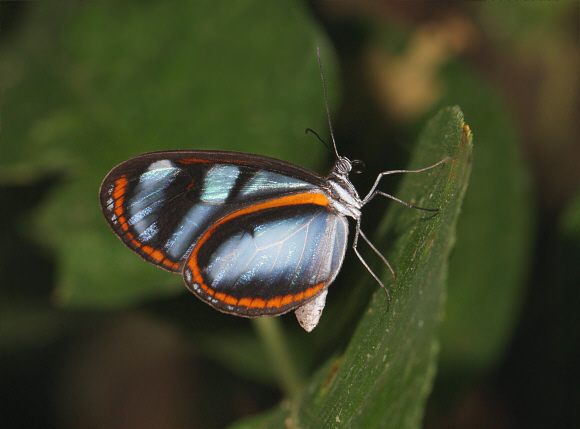
Introduction
The Ithomiini comprises of 376 known species, although it is likely that at least another 30 will be discovered in the near future. All are confined to the neotropical region. Ithomiines are unpalatable to birds, and are consequently mimicked in appearance by many other species. These include other unpalatable species ( Müllerian mimics ), not only from the Ithomiinae but also from several other butterfly families. There are also a large number of edible species ( Batesian mimics ) which have evolved similar patterns. Birds have the ability to memorise butterfly patterns and so learn to avoid eating noxious species, but are also fooled into ignoring similarly marked edible species.
Ithomiines are characterised by having small eyes, slender abdomens and long drooping antennae that lack distinct clubs. Males have a plume of long androconial scales or “hair pencils” on the costa of their hindwings. These are hidden from view when the butterflies are at rest, but are displayed when the wings are held open during courtship. Other Ithomiine characteristics include a very slow and deep wing beat, and a preference for inhabiting the darkest recesses of the forest understorey.
There are basically 2 types of Ithomiine. The first type are the black and orange-banded “tigers”, many of which are mimicked by other species due to their unpalatability to birds. The second type are the “glasswings”, recognised by their transparent or translucent wings, prominent veins, and orange wing margins. Many genera contain examples of both of these types, and in some cases an individual species may produce adults of both forms according to location.
The genus Oleria comprises of about 50 known species, characterised by the distinctive venation of the hindwings.
Oleria enania is found in eastern Peru and the southern Amazonian regions of Brazil.
Habitats
This species is associated primarily with wet tropical rainforest habitats, and is most commonly found in shady damp areas, at altitudes between 200-800m.
Lifecycle
I have no data specific to enania but the following generalisations can be regarded as applicable to the genus Oleria : The eggs are white. They are laid singly although several may be dotted about on one plant by any particular female. The larvae are dull greyish-green, with a wrinkled texture, and have small shiny black heads. They feed on Solanum or Lycianthes ( Solanaceae ). The pupae are usually pale green, unmarked, and have compressed abdominal segments and a dorsal hump.
Adult behaviour
The adults are normally found in small “leks” of up to a dozen butterflies. The males fly very slowly and almost incessantly around the lek area, only pausing to settle for a moment here and there, at which time they slowly fan their wings, probably to aid dissemination of pheromones from the androconial “hairs” on their wings.
Males of most Oleria species visit Eupatorium, from which they acquire pyrrolizidine alkaloids which they pass to the females during copulation, and which is believed to be essential for the production of viable eggs.
Females visit various flowers for nectar and pollen – the latter may be essential in the production of eggs and the maintenance of ovaries, as has been demonstrated by Dunlap-Pianka to be the case with Heliconiines. Females also receive proteins during sperm transfer.
